CHAPTER 1 Embryologic Basis and Segmental Approach to Imaging of Congenital Heart Disease
There is incredible diversity in the types of human hearts. The first step to accurate diagnosis and management of congenital heart disease is a standardized and logical approach to not only understanding, but also describing, the disease process. This is called the segmental approach to heart disease,1–3 first proposed by Richard Van Praagh in 1972, and later modified by others.4 It is strongly rooted in embryologic principles, and follows a logical sequence from evaluation of morphology and physiology of the heart to decision making regarding treatment. This chapter will summarize the key events of cardiac development and link them to the developmental pathology of the common congenital heart diseases. The discussion of embryology will follow a morphologic approach, and will lay the groundwork for understanding the segmental approach to heart disease by cross-sectional imaging. The molecular genetic basis of cardiac development and congenital heart disease is beyond the scope of this chapter.
CARDIAC EMBRYOLOGY
Formation of the Heart Tube
During the first 2 weeks of embryonic life, there is no heart or vascular system. Cell-to-cell diffusion provides nutrient and oxygen supply to the fetus. As the fetus grows, the stored food supply in the yolk sac is unable to support fetal life, and the cardiovascular system must develop to transfer nutrition from the maternal umbilical cord. The heart develops from two simple epithelial tubes that fuse to form a single-chambered heart that is efficiently pumping blood by the fourth week of embryonic development. The origins of the heart tube are clusters of angiogenic cells that are located in the cardiogenic crescent. The cardiogenic crescent is derived from splanchnopleuric mesoderm, and is located cranial and lateral to the neural plate. These angiogenic cell clusters coalesce to form right and left endocardial tubes.5 Each tube is continuous cranially with a dorsal aorta, its outflow tract, and caudally with a vitello-umbilical vein, its inflow tract. The lateral and cranial folding of the embryo forces the tubes into the thoracic cavity. As a result, these tubes come to lie closer to each other and begin to fuse in a cranial to caudal direction. At approximately day 21, they are completely fused. The splanchnic mesoderm around the heart tube thickens and forms the myoepicardial mantle (future myocardium and epicardium).
Components of the Heart Tube
From caudal to cranial, the following components of the newly formed heart tube (Fig. 1-1) are:
Bulboventricular Looping and Formation of the Ventricles
Whereas the two ends of the heart tube remain relatively fixed, rapid growth of the middle section results in the development of a large S-shaped curve called the bulboventricular loop (Fig. 1-2). As the heart tube grows and becomes longer, it usually bends to the right, termed by Van Praagh as D-looping.1,3 D-looping is responsible for the proximal bulbus cordis (RV) lying anterior and to the right of the primitive ventricle (LV). If the heart tube loops to the left, termed L-looping, the RV will lie anterior and to the left of the LV. The mechanisms underlying normal looping are still being studied, but they are under strong genetic control.6–8 Failure of normal looping (i.e., looping of the heart tube to the left) is a very early embryologic defect,9 and it is not surprising that associated defects of septation and valve formation are the rule rather than the exception.
Formation of the Ventricles and Interventricular Septum
In the newly formed bulboventricular loop, the primitive right and left ventricles appear as expansions in the heart tube. The interventricular sulcus/ridge separates the right and left ventricles (Fig. 1-3). Both ventricles will continue to expand until the late 7th/early 8th week. The growth of the ventricles is due to the centrifugal growth of the myocardium and the diverticulation of the internal walls, which gives the ventricle its trabeculated appearance. The development of the interventricular septum begins around the 27th day of gestation. It develops from three embryonic components: the endocardial cushions, the conus cushions, and the muscular septum (Fig. 1-4). The fusion of the opposing ventricular walls gives rise to the muscular interventricular septum. The endocardial cushions divide the inflow tracts from the ventricles. The conus cushions divide the outflow region of the ventricles.
Division of the Atrioventricular Canal
Because the proximal bulbus cordis gives rise to the RV, blood flows in series from the primitive atrium to the left ventricle, and then to the RV (see Fig. 1-1). There is no direct communication between the atria and the RV—even after the formation of the bulboventricular loop. The atrioventricular canal must shift to the right to achieve communication to the right ventricle in addition to the left ventricle (see Fig. 1-3). Swellings of mesenchymal tissue, the endocardial cushions, appear on the borders of the atrioventricular canal. There are four cushions: inferior and superior (ventral and dorsal), left and right. These are the precursors of the atrioventricular valves and they function during this early development as primitive valves. The endocardial cushions grow toward each other and fuse at approximately day 42, separating the atrioventricular canal into two openings which will eventually become the tricuspid and mitral valves (Fig. 1-4). The fused endocardial cushions are also responsible for the closure of the ostium primum by fusing with the free edge of the septum primum.
Developmental Pathology
Failure of the endocardial cushions to form will produce an AV canal defect (also known as an endocardial cushion defect). Incomplete endocardial cushion formation leads to variations of primum atrial septal defect, AV valve malformations, and/or inlet ventricular septal defect. Failure of the endocardial cushion tissue to shift over both ventricles can result in both AV valves entering the primitive left ventricle, forming a double inlet left ventricle. Failure of the endocardial cushions to shift to their normal position over the ventricles, combined with problems in ventricular septation, can also produce an “unbalanced AV canal” with a large single valve situated primarily over one ventricle.10
The tricuspid and mitral valves are formed by the endocardial cushion tissue. Stenosis of the atrioventricular valves is probably the result of partial fusion, whereas atresia of the atrioventricular valves probably results from complete fusion of the tissue.5
Formation of the Ventricular Outflow Tracts and Septation of the Truncus Arteriosus
In the heart tube stage, the primitive LV and the proximal bulbus cordis (primitive RV) are separated from the truncus arteriosus (which gives rise to both great arteries) by the conus or infundibulum (Fig. 1-5). This fact is fundamental to the understanding of the conotruncal malformations, which are due to abnormal development of the conus. The conus consists of the subpulmonary and subaortic conus cushions. Normally, there is expansile growth of the subpulmonary conus, causing it to protrude anteriorly on the left, carrying the pulmonary valve anteriorly, superiorly, and to the left of the aortic valve. There is resorption of the subaortic conus. Hence, the aortic valve lies posterior, inferior, and right-sided, in direct fibrous contiguity with the mitral valve (Fig. 1-6). Anterior protrusion of the pulmonary conus also twists the developing great arteries because they are fixed distally by the arterial arches. Spiral twisting of the growing tissue and a shift of the conal base to the middle causes the outflow tracts to align with the nearest ventricle (see Fig. 1-5). The anterior pulmonary artery arises above the anterior ventricle (RV) and leads to the posterior sixth arterial arch, which forms the branch pulmonary arteries. The posterior aorta originates above the posterior LV, and leads to the anterior fourth arterial arch (which forms the aortic arch). Recent investigation has shown that this normal partitioning of the conus involves migration of mesenchymal cells from the neural crest.11
By the 28th day of development, the truncus arteriosus divides by means of a bisecting spur that protrudes from both the aorta and pulmonary artery. The resultant aorticopulmonary septum continues in a spiral fashion toward the conus cordis until the two vessels are completely separated, giving rise to the aortic and pulmonary channels (see Fig. 1-5). The truncal cushions meet the conal cushions to complete the closure of the base of the respective outflow tracts.5 At the level of the conus cordis, the truncal swellings develop into pulmonary and aortic valve cusps and form two of the three cusps in each valve. A third swelling, the intercalated swelling, forms the third cusp.
Developmental Pathology
Abnormal conal development can result in tetralogy of Fallot or abnormal connections between the great vessels and the ventricles such as truncus arteriosus, transposition of the great arteries, double outlet RV, or double outlet LV (see Fig. 1-6).
Tetralogy of Fallot occurs when anterior displacement of the conal septum results in a narrowed pulmonary outflow tract, subsequent RV hypertrophy, an inability of the ventricular septum to close, and an abnormally placed aorta, overriding the VSD.5
Truncus arteriosus occurs when there is atresia of the subpulmonary conus, with absence of the pulmonary valve, resulting in a common vessel through which blood flows out of the heart to both pulmonary and systemic circulations.12 Because the absent or hypoplastic truncal cushions cannot meet the conal tissue, an obligatory VSD is present.
Transposition of great arteries was previously thought to be related to a failure of spiral twisting of the aorticopulmonary septum. But now, it is believed to result from variations in differential growth of the aortic and pulmonary conus.13 For instance, the most common form, D-transposition, is due to persistence and overgrowth of the subaortic conus and resorption of the subpulmonary conus. This elevates the aortic valve superiorly, protrudes it anteriorly above the RV, and causes aortic-tricuspid valve fibrous discontiguity. The pulmonary valve stays posterior and inferior, above the posterior LV, and in direct fibrous contiguity with the mitral valve.
The double outlet right ventricle results from variable development of both the subaortic and subpulmonary conus, and failure of the conus to shift to the center, with both great vessels arising from the primitive bulbus cordis (eventually the RV).5
The semilunar valves are formed from three small tubercles of tissue. A failure to develop one of the tubercles causes bicuspid aortic or pulmonary valves. Fusion of two or all three of the valve leaflets produces stenosis or atresia of the valve.5
Formation of the Interatrial Septum
By the time the heart tube has formed the bulboventricular loop, the primitive right and left atria have fused to form a common atrium, which lies cranial to the primitive ventricle and dorsal to the bulbus cordis (see Fig. 1-1D). The truncus arteriosus lies on the roof of the common atrium causing a depression and indicates where septation of the atrium will occur (see Fig. 1-5A). The interatrial septum forms between the 27th and the 37th day of development and occurs in conjunction with the development of the ventricular septum and separation of the truncus arteriosus.
A crest of tissue known as the septum primum grows from the dorsal wall of the atrium toward the endocardial cushions (Fig. 1-7). The ostium (opening) formed by the free edge of septum primum is the ostium primum. Before the septum primum fuses with the endocardial cushions, perforations appear in the upper portion of the septum primum. These perforations will coalesce to form the ostium secundum. Another muscular ridge of tissue known as the septum secundum arises from infolding of the dorsal wall of the atrium, to the right of the septum primum, and covers the ostium secundum. Its free edge forms the foramen ovale. The left venous valve and the septum spurium, located on the dorsal wall of the right atrium, fuse with the septum secundum as it grows.
Developmental Pathology
If the septum secundum fails to form and cover the perforations in the septum primum, the result is a secundum atrial septal defect (ASD). If the very last portion of the septum primum fails to meet with endocardial cushion tissue (coming from lower in the heart), a primum ASD is formed. Embryologists also speculate that if the septum primum perforations fail to form or close prematurely, the diminished right-to-left flow and diminished left-sided volume in utero result in underdevelopment of the left-sided structures, producing hypoplastic left heart syndrome.14
Formation of the Right Atrium, Coronary Sinus, and Systemic Veins
Unlike the atria, the sinus venosus remains a paired structure with right and left horns. Each sinus venosus receives blood from the yolk sac via the vitelline veins, from the chorionic villi via the umbilical veins, and from the cranial region of the embryo and body via the anterior and posterior cardinal veins. The fate of each structure is as follows (Fig. 1-8):
Formation of the Left Atrium and Pulmonary Veins
Development of the left atrium occurs concurrently with that of the right atrium. During the early part of the fourth week, a single pulmonary vein develops as an outgrowth from the back of the left atrium (Fig. 1-9), grows toward the developing lungs, and connects to the blood vessels growing out of the lungs to form pulmonary venous drainage.10 As the left atrium expands, it incorporates both the vein and, eventually, the four connecting pulmonary vessels. As the atrial wall expands, the smooth tissue of the pulmonary veins is incorporated into the wall of the atrium and displaces the trabeculated tissue anteriorly and laterally which will then form the left atrial appendage.
Developmental Pathology
Anomalous pulmonary venous return occurs when the single pulmonary vein fails to fuse with the developing intrapulmonary vessels, either because of lack of development or because of early involution.5 If the intrapulmonary vessels do not connect to the pulmonary vein, they can connect to other “alternative” vessels, such as the superior vena cava, inferior vena cava, the right atrium, the coronary sinus, or other vascular structures.15

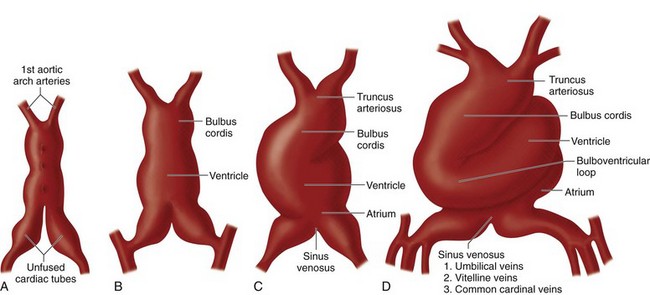
 FIGURE 1-1
FIGURE 1-1
 FIGURE 1-2
FIGURE 1-2
 FIGURE 1-3
FIGURE 1-3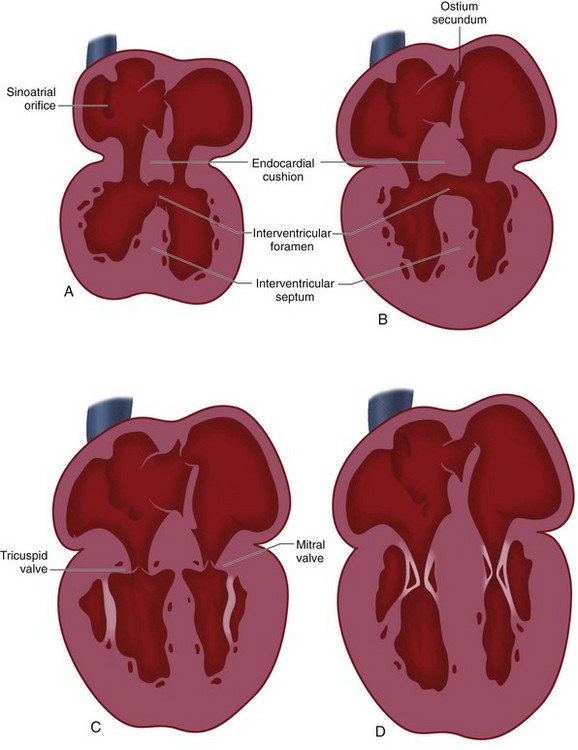
 FIGURE 1-4
FIGURE 1-4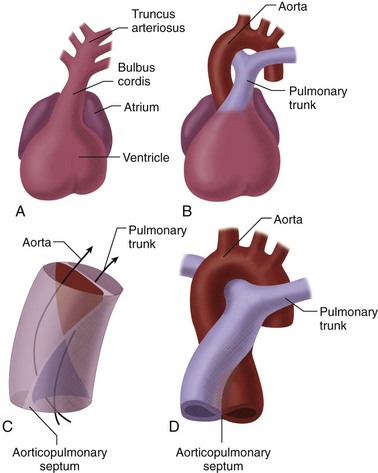
 FIGURE 1-5
FIGURE 1-5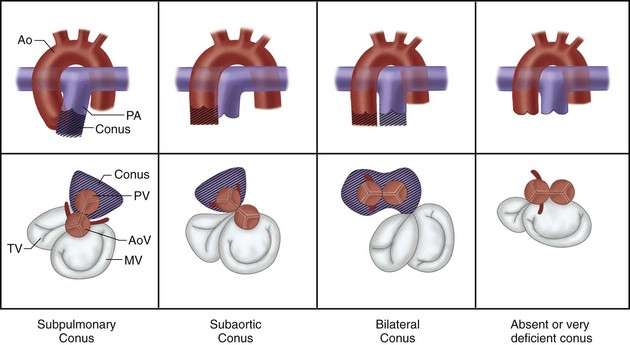
 FIGURE 1-6
FIGURE 1-6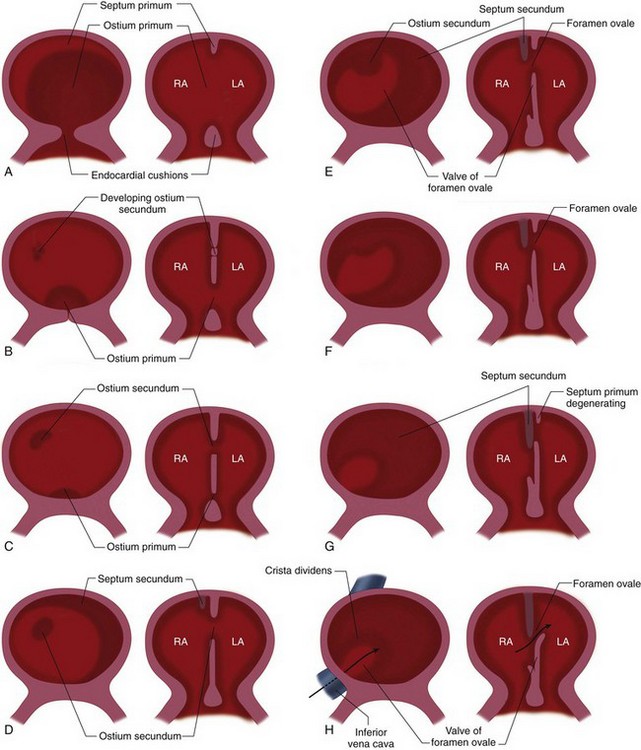
 FIGURE 1-7
FIGURE 1-7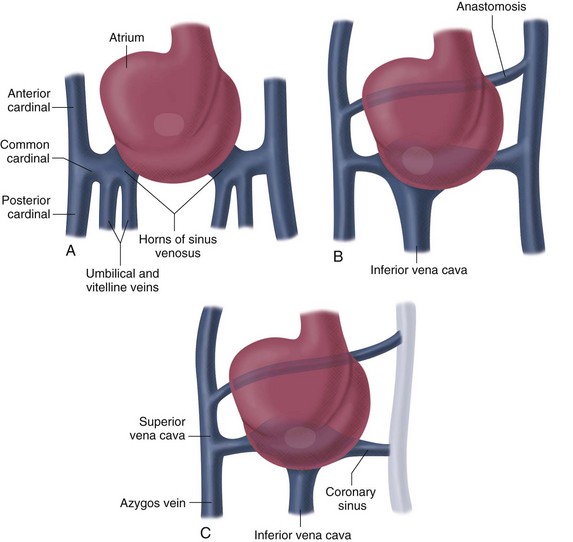
 FIGURE 1-8
FIGURE 1-8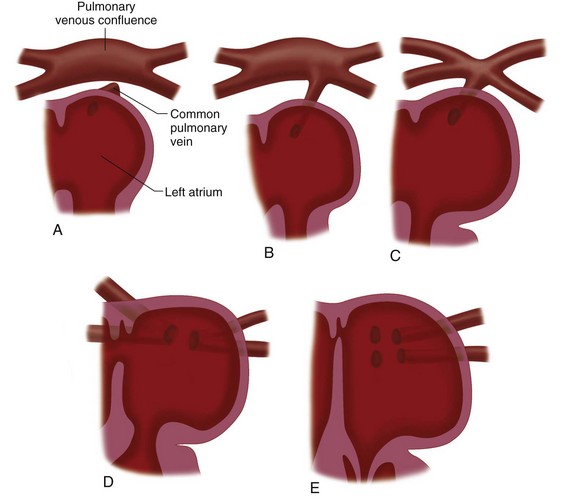
 FIGURE 1-9
FIGURE 1-9